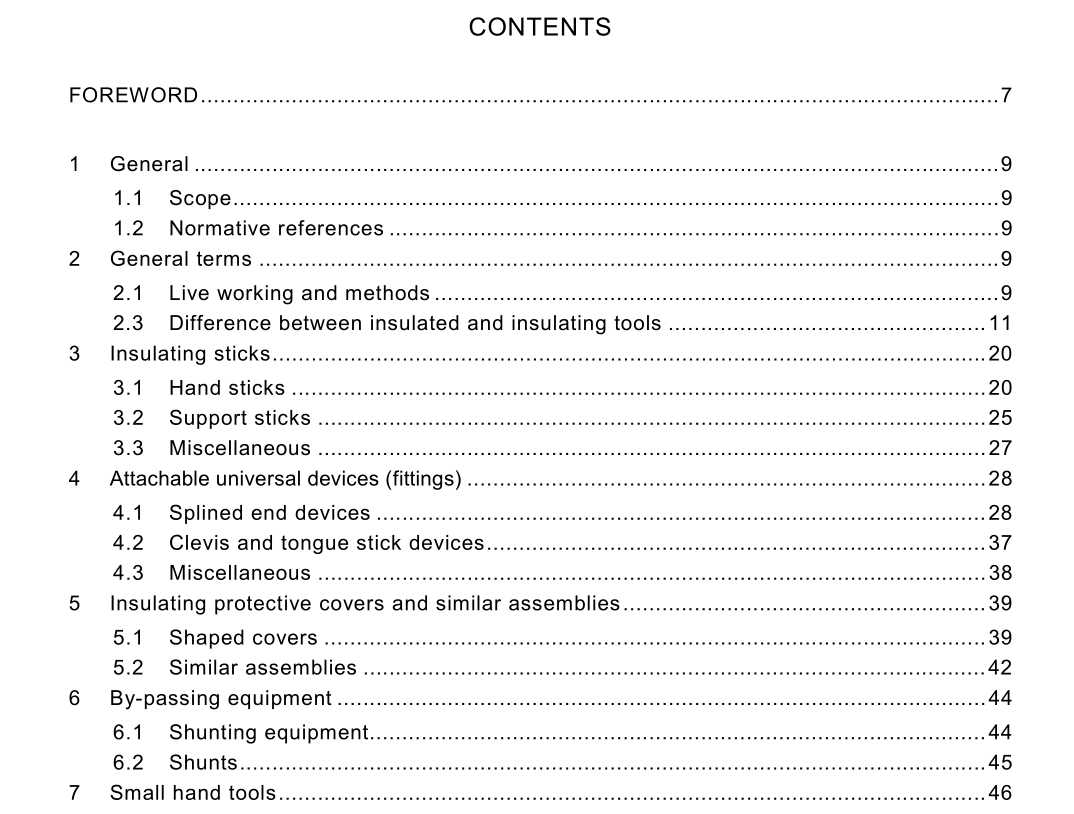IEC 60743 pdf download

IEC 60743 pdf download.Live working– Terminology for tools, equipment and devices
1 General
1.1 Scope This International Standard applies to the terminology used to describe tools, equipment, devices and methods used in live working. IEC 60050(651) gives the definitions of all terms used in live working. The present standard permits identification of the tools, equipment and devices and standardizes their names. 1.2 Normative references The following normative documents contain provisions which, through reference in this text, constitute provisions of this International Standard. For dated references, subsequent amendments to, or revisions of, any of these publications do not apply. However, parties to agreements based on this International Standard are encouraged to investigate the possibility of applying the most recent editions of the normative documents indicated below. For undated references, the latest edition of the normative document referred to applies. Members of IEC and ISO maintain registers of currently valid International Standards. IEC 60050(195):1998, International Electrotechnical Vocabulary – Chapter 195: Earthing and protection against electric shock IEC 60050(651):1999, International Electrotechnical Vocabulary – Chapter 651: Live working Guide ISO-IEC 51 :1990, Guidelines for the inclusion of safety aspects in standards ISO 472:1999, Plastics – Vocabulary
2 General terms
2.1 Live working and methods 2.1.1 live working (live work) activity in which a worker makes contact with energized or charged live parts or penetrates inside a live working zone with either parts of his or her body or with tools, equipment or devices being handled NOTE 1 Examples of live working include maintenance, connection and disconnection operations. NOTE 2 Live working is performed using specific methods: hot stick working, insulating glove working and bare hand working. [IEV 651-01-01 modified] 2.1.2 live part conductor or conductive part intended to be energized in normal operation, including a neutral conductor, but by convention not a PEN conductor [IEV 195-02-12] or PEM conductor [IEV 195-02-13] or PEL conductor [IEV 195-02-14] NOTE This concept does not necessarily imply a risk of shock. [IEV 651-01-03 modified] 2.1.3 live working zone space around live parts where prevention of electrical hazard is assured by suitable means such as limiting access to skilled persons, maintaining the appropriate air distances and using tools for live working NOTE 1 The limits of a live working zone are equal to or greater than the minimum working distance. NOTE 2 The live working zone and the specific precautions that apply are generally defined by national or company regulations. NOTE 3 In some countries the terms “danger zone” or “guard zone” are used instead of live working zone. [IEV 651-01-06 modified] 2.1.4 hot stick working live working according to a method whereby the worker remains at a specified distance from the live parts and carries out the work by means of insulating sticks [IEV 651-01-09] 2.1.5 insulating glove working live working according to a method whereby the worker is electrically protected by insulating gloves and other insulating equipment and carries out the work in direct mechanical contact with live parts [IEV 651-01-10] 2.1.6 bare hand working live working according to a method whereby the worker carries out the work in electrical contact with live parts, having the potential of the worker’s body raised to the voltage of the live parts by electrical connection, and suitably isolated from the surroundings at a different potential [IEV 651-01-11] 2.2 tools for live working tools, devices and equipment specifically designed or adapted, tested and maintained as apparatus for live working [IEV 651-01-24 modified]2.5.4 support stick insulating stick used to hold or move conductors and other equipment [IEV 651-12-12] 2.5.5 insulating assemblies various arrangements of support sticks and accessories for lifting, moving and/or supporting loads such as conductors, insulators, etc. 2.6 protective cover rigid or flexible cover made of insulating material used to cover live and/or dead parts and/or adjacent earthed (grounded) parts in order to prevent contact NOTE 1 A protective cover is only used to provide protection when a worker inadvertently comes into momentary contact with the protective cover. NOTE 2 The selection of the protective cover is based on the system operating voltage. [IEV 651-04-01 modified] 2.7 working distance air distance in the work location, determined to sustain the required insulation level for live working, and being ensured either by physical means or by skilled person following instructions and procedures [IEV 651-01-19 modified] 2.7.1 minimum working distance minimum approach distance minimum distance in air to be maintained between any part of the body of a worker, including any object (except appropriate tools for live working) being directly handled, and any parts at different potentials NOTE 1 The minimum working distance is the sum of the electrical distance, corresponding to the maximum nominal voltage calculated in accordance with IEC 61472, and the selected ergonomic distance appropriate to the work being undertaken. NOTE 2 “Appropriate tools” are tools for live working suitable for the maximum nominal voltage of the live parts. [IEV 651-01-20 modified]









